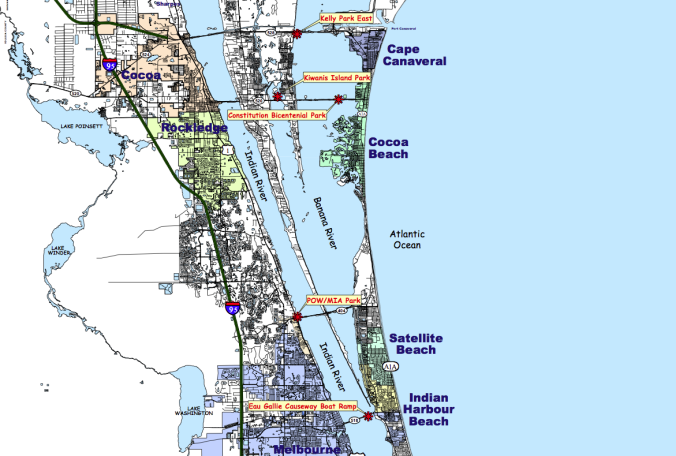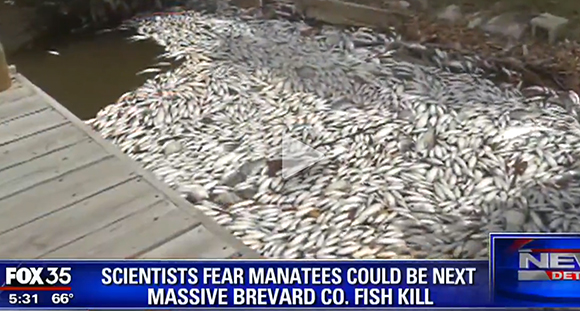
NEARLY HALF OF THE INDIAN RIVER LAGOON’S (IRL) 156 MILE LENGTH AND NEARLY 3/4 OF ITS AREA ARE WITHIN BEVARD COUNTY. IRL IS ONE OF THE LONGEST BARRIER ISLAND COMPLEXES IN THE U.S., OCCUPYING MORE THAN 30% OF FLORIDA’S EAST COAST.
On February 7, 2017, Vero Beach City Council, with a three to two majority, voted to decline any further consideration of funding a Stormwater Utility and impose City residents a $ 5.00 monthly fee for a strictly specified time; to raise money to protect the Lagoon from toxins and other harmful chemicals running off parking lots, roadways and impervious surfaces.
But on November 12, 2016 Brevard County residents overwhelming voted (62%) to approve a a resolution for a half cent sales tax, which is expected to raise roughlty over $ 34 million a year for a decade, representing roughly a total $ 340,000,000, to fund IRL clean-up projects. The vote was 190,404 to 115,010
The tax went into effect on January 1, 2017.
The initiative, called “Save Our Lagoon Project Plan” proposes a series of projects over the next 10 years to remove muck, fund stormwater projects, upgrade wastewater treatment facilities, remove and upgrade septic systems, manage fertilizer usage, initiate oyster reef projects and provide public education.
Muck is rotted plant matter, clays and soils from construction sites, blocking sunlight to seagrass and contributes to bacterial decay, which consumes oxygen in the water, causing fish kills.
Over five decades, the Florida Institute if Technology estimated 5 million to 7 million cubic yards of muck have built up in the Brevard and Indian River County’s portion of the IRL. Scientists said that’s enough muck to cover a football field 1,000 yards high.

In addition to the build-up of the muck, in the spring of 2016 the IRL in Brevards County experienced algae blooms, brown tide, and massive fish kills blamed on brown algal blooms.
This fueled the “Save Our Lagoon Project Plan.”
Algae blooms are the result of an excess of nutrients, particularly phosphates and nitrogen. When phosphates and nitrogen are introduced into water systems, higher concentrations cause increased growth of algae.
Algae tend to grow very quickly under high nutrient availability, but each alga is short-lived, and results in a high concentration of dead organic matter, which starts to decay. The decay process consumes dissolved oxygen in the water causing animals and plants to die off in large numbers.
Last spring, Zack Jud, Ph.D., the Director of Education and Exhibits with the Florida Oceanographic Society in Hutchinson Island said the massive fish fills could move south.
He said the news of dead fish in Brevard County is “nauseating,” and is extremely concerned for the waterways and wildlife there.
According to Mr. Jud, the fish kill spread thirty miles across the Banana River and killed off at least fifty species of fish.
He added that what’s happening in Brevard County is an “environmental and economic catastrophe” because if the fish don’t come back, it could push residents and businesses out of the area.
It could also kill off other animals that rely on those fish as a food source.
“The fish kill that happened 70 miles to our north, is really right on our doorstep,” he said. “That fish kill could spread as far south as Stuart.”
The Save the Lagoon Plan estimates a $2.01 billion positive economic impact from restoration of the lagoon.
This compares to $4.29 billion in damages if the lagoon is not brought back to health during the next decade. The Plan focused on three areas of economic impact: tourism and recreation, property values and commercial fishing.
Forty-two projects designed to help clean up the Indian River Lagoon were unanimously approved on March 7, 2017 by the Brevard County Commissioners, allocating a total of $25.87 million to those projects from the special half-cent-per-dollar sales tax. The total cost of these projects is $68.77 million, and the rest of the money would come from other funding sources.
According to Dave Berman of Florida Today, “In all, the 42 projects will reduce nitrogen going into the lagoon by 96,956 pounds a year and will reduce the phosphorous going into the lagoon by 10,109 pounds a year”
Approved projects
These are the 42 projects approved by Brevard County commissioners, along with the amount of Save Our Indian River Lagoon money allocated. They are listed under the entity that submitted the funding request:
Brevard County
Grand Canal muck dredging, $10 million
Sykes Creek muck dredging, $10 million
Mims muck removal, outflow water nutrient removal, $400,000
Kingsmill-Aurora phase two stormwater project, $367,488
Denitrification retrofit of Johns Road Pond, $105,512
Denitrification retrofit of Huntington Pond, $104,720
L1 Canal bank stabilization stormwater project, $87,560
Denitrification retrofit of Flounder Creek Pond, $75,328
Brevard County Parks Department
Long Point Park upgrade $101,854
Cape Canaveral
Central Boulevard baffle box, $34,700
International Drive baffle box, $34,700
Center Street baffle box, $26,136
Angel Isles baffle box, $11,528
Holman Road baffle box, $6,248
Carver Cove swale, $2,816
Cape Shores swales $2,746
Hitching Post berms $2,552
Cherie Down Park swale $2,376
Cocoa Palms stormwater project, $1,144
Justamere Road swale $528
Cocoa
Church Street type II baffle box, $20,856
Indian Harbour Beach
Gleason Park reuse $4,224
Melbourne
Cliff Creek baffle box $347,781
Thrush Drive baffle box $322,200
NASA Boulevard pond retrofit $96,532
Hoag sewer conversion $86,031
Penwood sewer conversion $40,632
Stewart Road dry retrofit $18,344
General Aviation Drive retrofit $13,937
Airport Boulevard dry retrofit $8,718
Merritt Island Redevelopment Agency
Merritt Island septic phase-out $320,000
Palm Bay
Norwood baffle box retrofit $143,528
Turkey Creek shoreline restoration $113,500
Goode Pond $69,872
Bayfront stormwater project, $30,624
Victoria Pond $23,486
Florin Pond $6,600
Rockledge
Breeze Swept septic-to-sewer connection, $880,530
Sebastian Inlet Marina
Micco sewer line extension, $1,391,316
Titusville
St. Teresa basin treatment stormwater project, $272,800
La Paloma basin treatment stormwater project, $208,296
South Street basin treatment stormwater project, $86,856
Source: Brevard County Natural Resources Management Department
Vero Beach City Council is going to regret the decision to pass on the plan to transfer stormwater costs to ratepayers (i.e. users of the system) in the form of a fee. Presently the cost is socialized, and paid by general taxes.
The fee-based approach is different than a tax: it provides a price signal–and incentive–for users to mitigate impacts onthe system, or opt-out entirely. Private individuals, businesses, and institutions that opt-out through mitigation effectively “privatize” a portion of the comprehensive stormwater system.
A tax, on the other hand, is fixed.
Second, the multi-year enterprise structure enable longer-range, and more rational planning and decision-making. At present, City officials cannot even rely on receiving funds that are in an approved budget, as budget funds may be– and are–raided for other purposes, without warning.
Most recently, $340,000 of stormwater grants awarded to the City had to be returned for lack of City matching funds that were raided. City staff work vey hard to bring in grants, and it must be very demoralizing for them to see their efforts ham-stung by the Council.
This unpredictability, and lack of demonstrated commitment to stormwater also makes it very difficult to win future grants, which can effectively supply up to 70% more money in matches. However, grantors are looking for a reliable partner with stable, longer-range funding.
Unless or until the City Council reverses it’s decision on structured stormwater funding, they will not be viewed as a reliable partner, and the taxpayers will continue to pay “full boat.”
LikeLike
Good stuff Tom
Sent from my iPhone
>
LikeLike
Pingback: Part Two: The Five Reporting Regions of the Indian River, FL Lagoon | Vero Communiqué